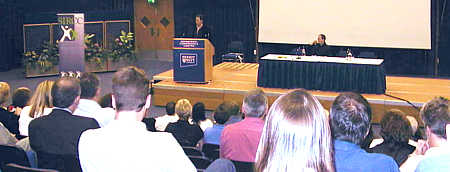Yes, I know, it’s been a wee while since the SIRCC (Scottish Institute for Residential Child Care) Conference held at the Heriot-Watt University Conference Centre in Edinburgh in June! The cyber surfers who remember old-fashioned postcards know how easy it is to get back home before the postcards. Well that’s the way it is with my SIRCC Postcard. This way, everyone who took part in that conference gets a chance to pause and reflect on some idea or practice they wanted to try out in the year ahead, or to ring someone they met up with at the conference. Most delegates were sorry that the organisers cut short Thom Garfat’s Keynote Address. They will remember Thom’s address about value-added practices with young people. While drawing from Canadian examples, his message resonated with Scottish practitioners and reaffirmed their work at the front line with kids. Well done, TG!

Dr Thom Garfat giving his Keynote Address on Day 2
It was a special privilege spending a day with Thom Garfat and a dozen youth workers at Kibble Education and Care Centre in Paisley on the day before the SIRCC conference. Good fortune also meant that the group was small enough to make full use of The Learning Centre @ Kibble. Bad fortune struck when Thom successfully locked the keys inside the rental car. Alas, good fortune once again prevailed when his Canadian Automobile Association Card got us successfully rescued!
Few of the participants in the Kibble Learning Centre Study Day will soon forget the exercise of going out in pairs for a 10-15 minute walk in the Scottish sunshine. During their walk, participants were instructed to try and get out of rhythm with the other person. Whenever they found themselves getting into some kind of rhythm, the pair had to consciously talk about it and do something to get out of rhythm. It is such a simple way of getting people to think about Henry Maier’s idea of rhythmicity in care and supervision work with young people. Rhythmicity is central to the purposeful interactions employed with young people in care. Rhythmicity is the voice of programming “highlighting the extent to which service activities connect and communicate pro-actively with young people and their families.

Kibble Education and Care Centre Residence
On our way home to New Zealand after our family visit in Scotland, Jane and I had opportunity to visit the North Rim of the Grand Canyon for three, unhurried days. Sitting there looking out over awe-inspiring panoramic vistas, my thoughts occasionally strayed to Henry’s notion of rhythmicity. I’ve had special opportunities in the past five years to visit Asia and Arabia. During my travels, I found that in formal Mandarin lessons, Chinese children learn to read sentences from the top down in what I learned was a visual syntax. As a child of the West, I learned to read from left to right, using an oral syntax. Instead of sound to picture (visual syntax) learning, I learned through sound to words (visual syntax). By further contrast, Arabian children learn to read from right to left. In the West, such readers might be diagnosed as dyslexic. Top down. Left to right. Right to left. If children learn in such ways from their earliest educational experiences, does it not follow that they learn to think differently? What implications might this present for road maps to peace, and international diplomacy? We've only just begun!